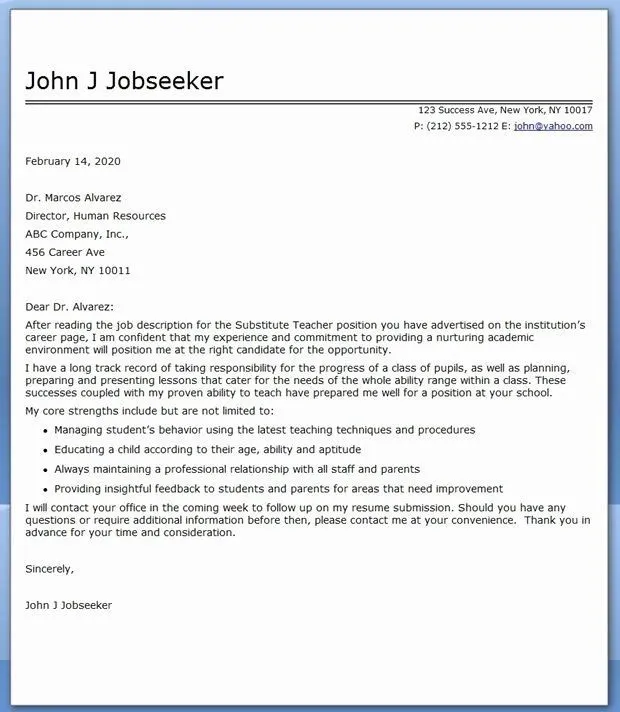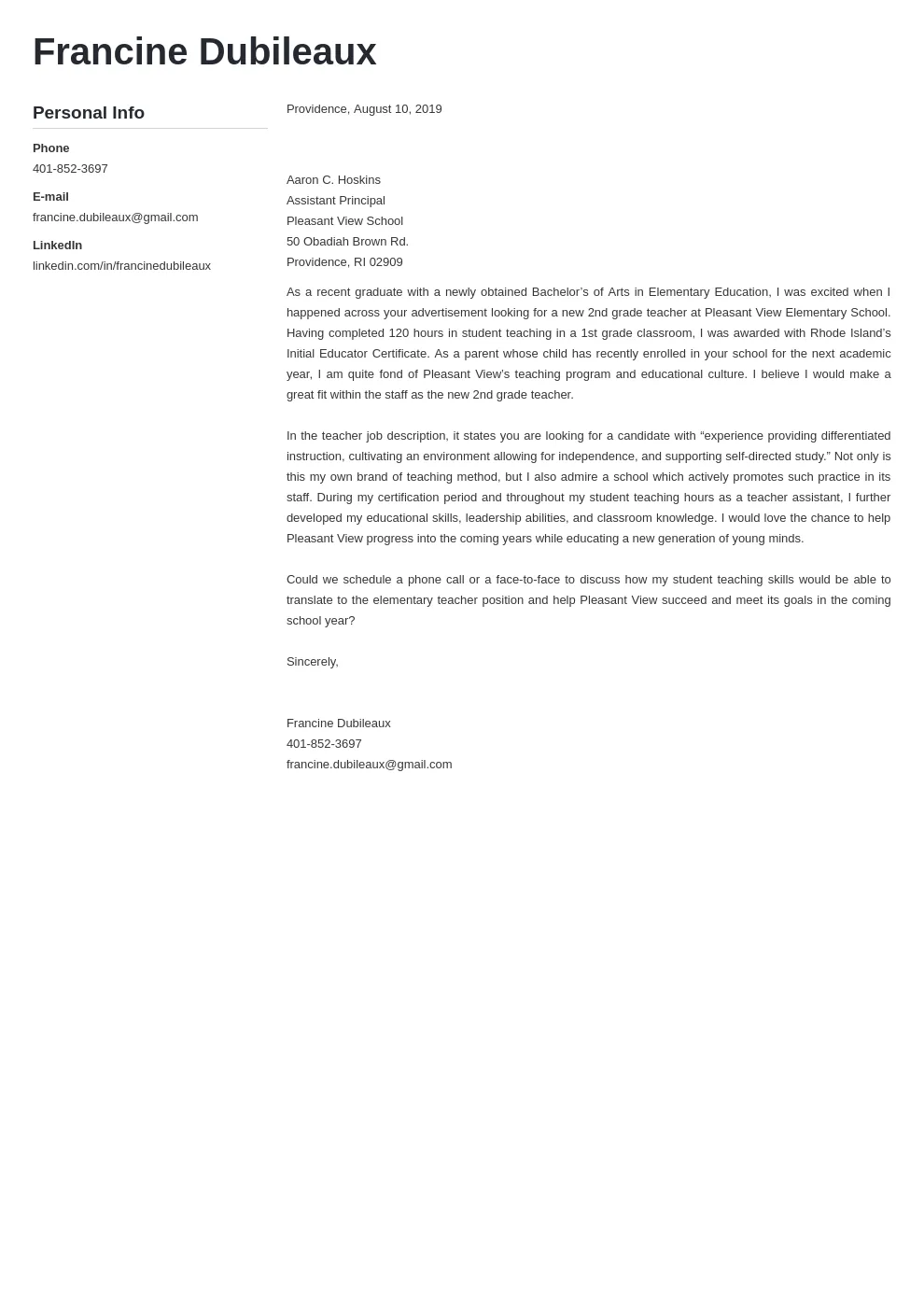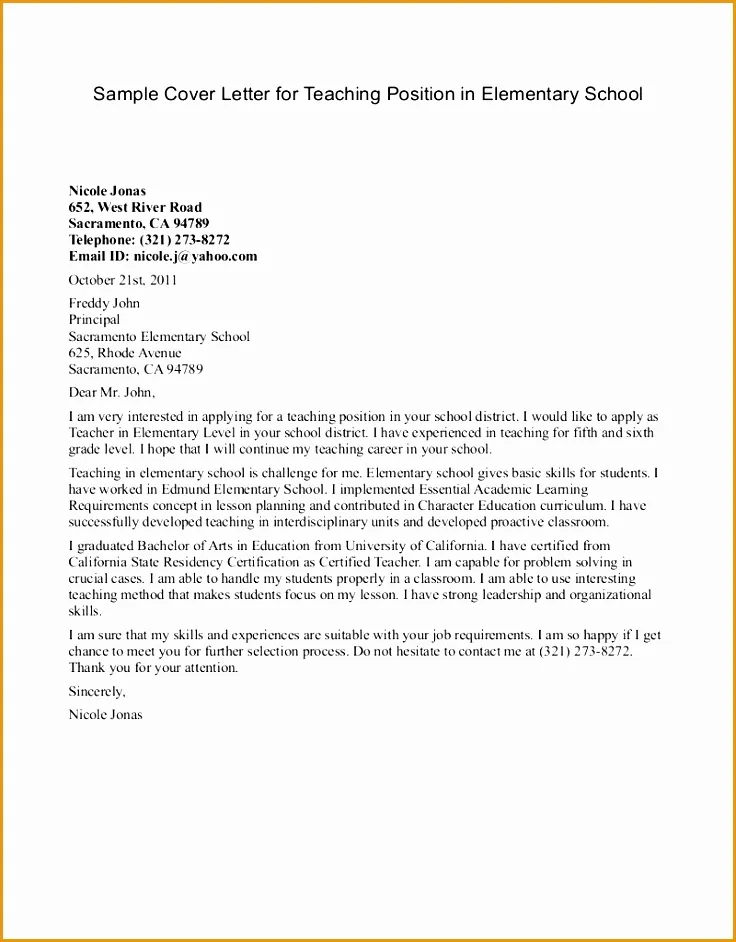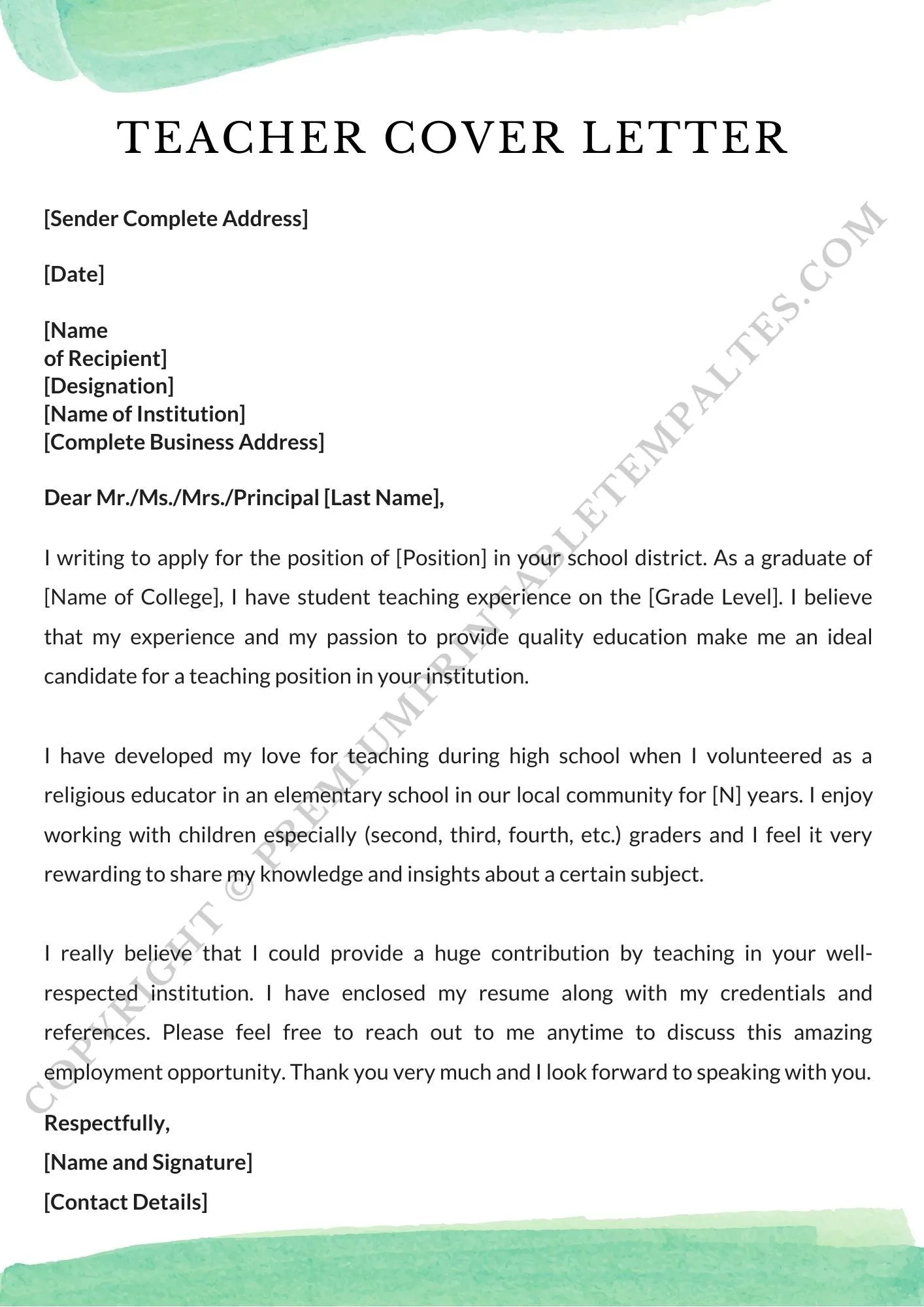Why a Cover Letter Matters for Teachers
As a fresher teacher embarking on your job search, a well-crafted cover letter is your first opportunity to make a strong impression. Unlike a resume, which simply lists your qualifications, a cover letter allows you to showcase your personality, teaching philosophy, and genuine enthusiasm for the role. It’s where you connect with the hiring committee on a personal level and articulate why you are the ideal candidate. Think of it as your chance to transform from a list of credentials into a compelling narrative of your potential. Your cover letter offers the chance to explain any gaps in your experience and to express your specific interest in the school or district to which you are applying. A thoughtfully composed cover letter sets the stage for a successful application, demonstrating your communication skills, attention to detail, and genuine interest in the position.
Key Components of a Teacher Cover Letter
A compelling teacher cover letter has specific key components. It begins with your header and contact information, immediately followed by a professional greeting and introduction. The body should highlight your skills and qualifications, focusing on how they align with the school’s needs. You must showcase any relevant experience, be it student teaching, volunteering, or other roles where you’ve worked with children. In addition, your passion for teaching should shine through – discuss your teaching philosophy, your excitement for working with students, and what motivates you to educate the next generation. Tailor the letter to the specific school by referencing their mission, values, or any programs that resonate with you. Finish by expressing enthusiasm and professionalism in the closing. The structure of your letter will significantly affect its impact. Make sure the letter is formatted correctly.
Header and Contact Information

The header of your teacher cover letter needs to be precise and professional. Start by including your full name, address, phone number, and professional email address at the top of the page. Your contact information should be easy to find and readily accessible to the hiring manager. Make sure the formatting is clean and consistent with your resume, reflecting your attention to detail. It’s also important to include the date and the recipient’s information (the hiring manager’s name, title, and the school’s address). If you don’t know the hiring manager’s name, research it online or call the school to ask. Addressing the letter to a specific person shows you’ve taken the initiative and have done your research, and will make you stand out. Always double-check all the information to ensure it is accurate, as even a small error can make a bad impression. Accurate contact information also increases the likelihood of a quick response.
Greeting and Introduction
Your greeting and introduction set the tone for the entire cover letter. Start with a formal salutation, such as “Dear Mr./Ms. [Last Name]” if you know the hiring manager’s name. If not, “Dear Hiring Committee” is a safe option. In your introduction, clearly state the position you are applying for and where you saw the job posting. Immediately capture their attention by briefly mentioning why you are a strong candidate or what excites you about the school. In your introductory paragraph, be concise, confident, and enthusiastic. This part is crucial; it’s your first chance to show the hiring manager your communication skills and to generate interest in reading the rest of your letter. A well-crafted introduction should serve as a hook, encouraging the reader to delve into the subsequent sections of your letter. Tailor your introduction to the specific school and position to increase its impact.
Highlighting Your Skills and Qualifications
This section is your opportunity to highlight your relevant skills and qualifications. Even as a fresher, you have skills, and you must present them in a clear and compelling way. Focus on the skills most relevant to the teaching role you are applying for, such as classroom management, curriculum development, lesson planning, and differentiating instruction. Provide specific examples from your student teaching experiences, volunteer work, or any other related experiences to support your claims. Use keywords from the job description to show that you possess the qualities the school is seeking. Quantify your achievements whenever possible; for instance, you could mention the number of students you’ve taught or any improvements in student performance. Ensure that your skills align with the school’s needs and values, demonstrating that you are a well-rounded candidate with the potential to make a significant contribution to the school community.
Showcasing Relevant Experience

Even if you’re a fresher, your experiences are valuable. This section is dedicated to showcasing all of your relevant experience. Focus on student teaching placements, internships, volunteer work, or any experience where you interacted with children or in an educational setting. Describe your responsibilities and accomplishments in detail, using the STAR method (Situation, Task, Action, Result) to give context to your experience. For example, describe a situation where you used a specific teaching method, the task you had to complete, the action you took, and the positive result you achieved. When discussing your experiences, highlight skills like classroom management, lesson planning, and communication. Be specific about the age group and subject matter you taught. By clearly articulating your experiences, you demonstrate to the hiring committee that you are prepared to take on a teaching role. Don’t be afraid to include extracurricular activities and special projects.
Emphasizing Your Passion for Teaching
Your passion for teaching is one of the most important aspects that you should express in your cover letter. This is where you showcase your personality and reveal why you are enthusiastic about a career in education. Discuss your teaching philosophy, your beliefs about education, and how you strive to create a positive and engaging learning environment. Talk about what inspires you and what motivates you to make a difference in students’ lives. Consider mentioning specific teaching methods or educational approaches that resonate with you. Be authentic and let your passion shine through your words. Describe why you are drawn to teaching and what you hope to achieve in the classroom. Remember, schools seek educators who genuinely love teaching and care about their students’ success. Letting your enthusiasm come through increases the chances of making a lasting impression.
Tailoring Your Letter to the Specific School
One of the most impactful things you can do in your cover letter is to tailor it to the specific school and position. Research the school’s mission statement, values, programs, and initiatives. Show that you understand the school’s culture and goals. In your letter, mention specific programs or teaching methods that align with the school’s approach. Reference any recent achievements by the school or district that resonate with you. For example, if the school emphasizes technology in the classroom, highlight your experience with specific educational software or tools. If the school values community engagement, mention your interest in participating in extracurricular activities. By demonstrating that you’ve researched the school and are genuinely interested in joining its community, you significantly increase your chances of making a favorable impression. Personalization shows you’re not just sending a generic cover letter; you’ve taken the time to learn about their institution.
Expressing Enthusiasm and Professionalism

Throughout your cover letter, maintain a tone of enthusiasm and professionalism. Use positive language and avoid any negative statements or complaints. Show that you are eager to learn and grow as an educator. Convey your excitement about the possibility of joining the school’s team and contributing to their mission. Your professionalism is also shown through your writing style, the way you present your qualifications, and your respectful tone. Proofread the letter carefully to eliminate errors in grammar and spelling. A professional cover letter is a reflection of you, and it indicates your ability to communicate clearly and effectively with others. Demonstrate your ability to make a positive impact. Be respectful and avoid any unprofessional language or slang. Maintain a formal and respectful tone. Keep the focus on how your skills and experiences align with the job requirements.
Formatting Your Teacher Cover Letter
Formatting is important. Choose a professional and easy-to-read font, such as Times New Roman or Arial, with a font size between 11 and 12 points. Use single spacing within paragraphs and double spacing between paragraphs. Use standard margins (1 inch on all sides). Divide your cover letter into clear sections with headings and subheadings to make it easy to scan. Keep the letter concise; aim for one page unless specifically instructed otherwise. Use bullet points to highlight key skills or achievements. Ensure that your cover letter is visually appealing. Use a clean layout with sufficient white space to make it easier to read. A well-formatted cover letter demonstrates your attention to detail and your commitment to excellence. Make sure the layout is consistent with your resume. Always double-check the formatting before submitting your cover letter to avoid any formatting issues.
Proofreading and Editing Your Letter
Proofreading and editing are crucial steps in the cover letter writing process. Always proofread your cover letter multiple times to catch any errors in grammar, spelling, or punctuation. Small mistakes can detract from your professionalism and credibility. Carefully review the content of your letter, ensuring that it flows logically and that your points are clearly articulated. Check for clarity and consistency in your writing style. Read your cover letter aloud to yourself to catch any awkward phrasing or sentences. Ask a friend, family member, or career advisor to review your cover letter and provide feedback. It helps to have a second pair of eyes to catch errors you might have missed. Make sure you have used the correct contact information and have included all the required information. Ensure that the language used is appropriate for a formal document. Proofreading and editing are essential to creating a flawless and polished cover letter.
Common Mistakes to Avoid in a Teacher Cover Letter

There are common mistakes that you must avoid when writing a teacher cover letter. Don’t make generic statements that could apply to any job; tailor your letter to the specific role and school. Do not simply repeat the information from your resume; use the cover letter to expand on your qualifications and provide specific examples. Avoid spelling and grammar errors, as they can create a negative impression. Don’t use overly informal language or slang. Never submit a cover letter without proofreading it. Don’t focus solely on what you want; show how you can benefit the school and contribute to its success. Never be negative or critical about previous employers or experiences. Avoid using clichés or overused phrases. Avoid any information not relevant to the job. Avoid lengthy, unfocused paragraphs. Make sure to tailor the letter for each job; do not use one cover letter for multiple job applications. Always keep it concise and to the point.
Writing a Strong Closing and Call to Action
Your closing paragraph should summarize your interest in the position and school. Reiterate your enthusiasm and your belief that you are a strong fit for the role. Include a call to action, inviting the hiring manager to contact you for an interview. Thank them for their time and consideration. Make it easy for them to reach out by restating your contact information. Keep your closing concise and professional. Express your anticipation for a positive response. Show that you are eager to move to the next step in the hiring process. A well-crafted closing paragraph leaves a lasting positive impression and increases your chances of being selected for an interview. Finish with a professional closing, such as “Sincerely” or “Respectfully,” followed by your typed name. Ensure your contact information is clearly visible.
